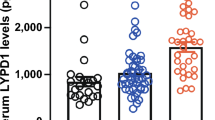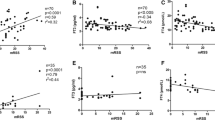Abstract
Systemic sclerosis (SSc) is characterized by chronic inflammation and fibrosis, two processes associated with transforming growth factor β (TGF-β) functions. In the present study, we investigated the expression of TGF-β isoforms in serum and the skin distribution of TGF-β and two receptors (TGF-βR1 and TGF-βR2) and their relationship with some clinical, inflammatory, autoimmune (autoantibodies), and vascular (platelets) biomarkers in SSc patients. A total of 56 SSc patients and 120 control subjects (CS) were included. The serum levels of TGF-β isoforms were quantified by immunoassay with magnetic microspheres, and the skin biopsies were processed by immunohistochemistry. The soluble levels of the three active TGF-β isoforms were lower in SSc patients than in CS (p < 0.0001). However, sTGF-β1 and sTGF-β3 levels were positively correlated with C-reactive protein levels in SSc patients. Additionally, sTGF-β2 and sTGF-β3 levels were positively correlated with the number of platelets in SSc patients. In skin biopsies, TGF-β1, TGF-βR1, and TGF-βR2 expression levels were higher in SSc patients than CS. In conclusion, this is the first study showing a joint decrease of the 3 active TGF-β isoforms in SSc patients. However, TGF-β1, TGF-βR1, and TGF-βR2 are possibly increased in clinically involved skin. Therefore, it is likely that a distinct role is played by TGF-β at the local (skin lesions) and systemic levels in SSc patients.



Similar content being viewed by others
References
Barsotti S, Bruni C, Orlandi M, Della Rossa A, Marasco E, Codullo V, et al. One year in review 2017: systemic sclerosis. Clin Exp Rheumatol. 2017;35(Suppl 106):3–20.
Royle JG, Lanyon PC, Grainge MJ, Abhishek A, Pearce FA. The incidence, prevalence, and survival of systemic sclerosis in the UK clinical practice research datalink. Clin Rheumatol. 2018;37:2103–11.
Baños-Hernández CJ, Navarro-Zarza JE, Bucala R, Hernández-Bello J, Parra-Rojas I, Ramírez-Dueñas MG, et al. Macrophage migration inhibitory factor polymorphisms are a potential susceptibility marker in systemic sclerosis from southern Mexican population: association with MIF mRNA expression and cytokine profile. Clin Rheumatol. 2019;38:1643–54.
Rubio-Rivas M, Corbella X, Pestaña-Fernández M, Tolosa-Vilella C, Guillen-Del Castillo A, Colunga-Argüelles D, et al. First clinical symptom as a prognostic factor in systemic sclerosis: results of a retrospective nationwide cohort study. Clin Rheumatol. 2018;37:999–1009.
Lomelí-Nieto JA, Muñoz-Valle JF, Baños-Hernández CJ, Navarro-Zarza JE, Ramírez-Dueñas MG, Sánchez-Hernández PE, et al. TNFA -308G>A and -238G>A polymorphisms and risk to systemic sclerosis: impact on TNF-α serum levels, TNFA mRNA expression, and autoantibodies. Clin Exp Med. 2019;19:439–47.
Bossini-Castillo L, Campillo-Davó D, López-Isac E, Carmona FD, Simeon CP, Carreira P, et al. An MIF promoter polymorphism is associated with susceptibility to pulmonary arterial hypertension in diffuse cutaneous systemic sclerosis. J Rheumatol. 2017;44:1453–7.
Machado-Sulbaran AC, Ramírez-Dueñas MG, Navarro-Zarza JE, Muñoz-Valle JF, Mendoza-Carrera F, Baños-Hernández CJ, et al. KIR/HLA gene profile implication in systemic sclerosis patients from Mexico. J Immunol Res. 2019;2019:6808061.
Yang C, Tang S, Zhu D, Ding Y, Qiao J. Classical disease-specific autoantibodies in systemic sclerosis: clinical features, gene susceptibility, and disease stratification. Front Med. 2020. https://doi.org/10.3389/fmed.2020.587773.
Bhattacharyya S, Wei J, Varga J. Understanding fibrosis in systemic sclerosis: shifting paradigms, emerging opportunities. Nat Rev Rheumatol. 2011;8:42–54.
Wynn TA. Cellular and molecular mechanisms of fibrosis. J Pathol. 2008;214:199–210.
Hirigoyen D, Burgos PI, Mezzano V, Duran J, Barrientos M, Saez CG, et al. Inhibition of angiogenesis by platelets in systemic sclerosis patients. Arthritis Res Ther. 2015;17:332.
Jinnin M. Mechanisms of skin fibrosis in systemic sclerosis. J Dermatol. 2010;37:11–25.
Lafyatis R. Transforming growth factor β–at the centre of systemic sclerosis. Nat Rev Rheumatol. 2014;10:706–19.
Farina G, Lafyatis D, Lemaire R, Lafyatis R. A four-gene biomarker predicts skin disease in patients with diffuse cutaneous systemic sclerosis. Arthritis Rheum. 2010;62:580–8.
Ayers NB, Sun C-M, Chen S-Y. Transforming growth factor-β signaling in systemic sclerosis. J Biomed Res. 2018;32:3–12.
Vander Ark A, Cao J, Li X. TGF-β receptors: In and beyond TGF-β signaling. Cell Signal. 2018;52:112–20.
Lichtman MK, Otero-Vinas M, Falanga V. Transforming growth factor beta (TGF-β) isoforms in wound healing and fibrosis. Wound Repair Regen Off Publ Wound Heal Soc Eur Tissue Repair Soc. 2016;24:215–22.
Dantas AT, Gonçalves SMC, de Almeida AR, Gonçalves RSG, Sampaio MCPD, de Vilar KM, et al. Reassessing the role of the active TGF-β1 as a biomarker in systemic sclerosis: association of serum levels with clinical manifestations. Dis Markers. 2016. https://doi.org/10.1155/2016/6064830.
Dziadzio M, Smith RE, Abraham DJ, Black CM, Denton CP. Circulating levels of active transforming growth factor beta1 are reduced in diffuse cutaneous systemic sclerosis and correlate inversely with the modified Rodnan skin score. Rheumatol Oxf Engl. 2005;44:1518–24.
Majewski D, Majewska KA, Kuznar-Kaminska B, Runowska M, Piorunek T, Batura-Gabryel H, et al. Systemic sclerosis and serum content of transforming growth factor. Adv Exp Med Biol. 2019;1153:63–7.
Sato S, Hasegawa M, Takehara K. Serum levels of interleukin-6 and interleukin-10 correlate with total skin thickness score in patients with systemic sclerosis. J Dermatol Sci. 2001;27:140–6.
Scala E, Pallotta S, Frezzolini A, Abeni D, Barbieri C, Sampogna F, et al. Cytokine and chemokine levels in systemic sclerosis: relationship with cutaneous and internal organ involvement. Clin Exp Immunol. 2004;138:540–6.
Varga J, Pasche B. Transforming growth factor-ß as a therapeutic target in systemic sclerosis. Nat Rev Rheumatol. 2009;5:200–6.
van den Hoogen F, Khanna D, Fransen J, Johnson SR, Baron M, Tyndall A, et al. 2013 classification criteria for systemic sclerosis: an American College of Rheumatology/European League against Rheumatism collaborative initiative. Arthritis Rheum. 2013;65:2737–47.
Sgonc R, Wick G. Pro- and anti-fibrotic effects of TGF-beta in scleroderma. Rheumatol Oxf Engl. 2008;47(Suppl 5):v5-7.
Blobe GC, Schiemann WP, Lodish HF. Role of transforming growth factor beta in human disease. N Engl J Med. 2000;342:1350–8.
Heldin CH, Miyazono K, ten Dijke P. TGF-beta signalling from cell membrane to nucleus through SMAD proteins. Nature. 1997;390:465–71.
Budzyńska-Włodarczyk J, Michalska-Jakubus MM, Kowal M, Krasowska D. Evaluation of serum concentrations of the selected cytokines in patients with localized scleroderma. Postepy Dermatol Alergol. 2016;33:47–51.
Querfeld C, Eckes B, Huerkamp C, Krieg T, Sollberg S. Expression of TGF-beta 1, -beta 2 and -beta 3 in localized and systemic scleroderma. J Dermatol Sci. 1999;21:13–22.
Yoon S-Y, Tefferi A, Li C-Y. Cellular distribution of platelet-derived growth factor, transforming growth factor-β, basic fibroblast growth factor, and their receptors in normal bone marrow. Acta Haematol Karger Publishers. 2000;104:151–7.
Kohama K, Nonaka K, Hosokawa R, Shum L, Ohishi M. TGF-beta-3 promotes scarless repair of cleft lip in mouse fetuses. J Dent Res. 2002;81:688–94.
Assoian RK, Komoriya A, Meyers CA, Miller DM, Sporn MB. Transforming growth factor-beta in human platelets. Identification of a major storage site purification and characterization. J Biol Chem. 1983;258:7155–60.
Meyer A, Wang W, Qu J, Croft L, Degen JL, Coller BS, et al. Platelet TGF-β1 contributions to plasma TGF-β1, cardiac fibrosis, and systolic dysfunction in a mouse model of pressure overload. Blood. 2012;119:1064–74.
Ramirez GA, Franchini S, Rovere-Querini P, Sabbadini MG, Manfredi AA, Maugeri N. The role of platelets in the pathogenesis of systemic sclerosis. Front Immunol. 2012;3:160.
Ntelis K, Bogdanos D, Dimitroulas T, Sakkas L, Daoussis D. Platelets in systemic sclerosis: The missing link connecting vasculopathy, autoimmunity, and fibrosis? Curr Rheumatol Rep. 2019;21:15.
Taylor AW, Ku NO, Mortensen RF. Regulation of cytokine-induced human C-reactive protein production by transforming growth factor-beta. J Immunol Baltim Md. 1950;1990(145):2507–13.
Gao J. Changes and significance of serum C-reactive protein and transforming growth factor-β 1 levels in patients with primary Sj?gren’s syndrome. Chin J Rheumatol. 2020;12:125–8.
Zhang R, Zhang YY, Huang XR, Wu Y, Chung ACK, Wu EX, et al. C-reactive protein promotes cardiac fibrosis and inflammation in angiotensin II–induced hypertensive cardiac disease. Hypertens Am Heart Assoc. 2010;55:953–60.
Sullivan DE, Ferris M, Nguyen H, Abboud E, Brody AR. TNF-alpha induces TGF-beta1 expression in lung fibroblasts at the transcriptional level via AP-1 activation. J Cell Mol Med. 2009;13:1866–76.
Yue TL, Wang XK, Olson B, Feuerstein G. Interleukin-1 beta (IL-1 beta) induces transforming growth factor-beta, (TGF-beta 1) production by rat aortic smooth muscle cells. Biochem Biophys Res Commun. 1994;204:1186–92.
Sun W, Wu Y, Gao M, Tian Y, Qi P, Shen Y, et al. C-reactive protein promotes inflammation through TLR4/NF-κB/TGF-β pathway in HL-1 cells. 2019. Biosci Rep. https://doi.org/10.1042/BSR20190888.
Liu X, Mayes MD, Pedroza C, Draeger HT, Gonzalez EB, Harper BE, et al. Does C-reactive protein predict the long-term progression of interstitial lung disease and survival in patients with early systemic sclerosis? Arthritis Care Res. 2013;65:1375–80.
Sfikakis PP, McCune BK, Tsokos M, Aroni K, Vayiopoulos G, Tsokos GC. Immunohistological demonstration of transforming growth factor-beta isoforms in the skin of patients with systemic sclerosis. Clin Immunol Immunopathol. 1993;69:199–204.
Kubo M, Ihn H, Yamane K, Tamaki K. Upregulated expression of transforming growth factor-beta receptors in dermal fibroblasts of skin sections from patients with systemic sclerosis. J Rheumatol. 2002;29:2558–64.
Cell atlas - TGFBR1 - The Human Protein Atlas [Internet]. [cited 2021 Aug 7]. Available from: https://www.proteinatlas.org/ENSG00000106799-TGFBR1/cell
Yakymovych I, Yakymovych M, Zang G, Mu Y, Bergh A, Landström M, et al. CIN85 modulates TGFβ signaling by promoting the presentation of TGFβ receptors on the cell surface. J Cell Biol. 2015;210:319–32.
Yakymovych I, Yakymovych M, Heldin C-H. Intracellular trafficking of transforming growth factor β receptors. Acta Biochim Biophys Sin. 2018;50:3–11.
Mu Y, Sundar R, Thakur N, Ekman M, Gudey SK, Yakymovych M, et al. TRAF6 ubiquitinates TGFβ type I receptor to promote its cleavage and nuclear translocation in cancer. Nat Commun. 2011;2:330.
Funding
This research was funded by the PRODEP- SEP Mexico, under Grant (number UDG-PTC-1433) assigned to J.H.-B; by the University of Guadalajara—Strengthening Research and Postgraduate 2018, under Grant (number 244159) assigned to J.F.M.-V, and by the Universidad de Guadalajara through Fortalecimiento de la Investigación y el Posgrado 2021.
Author information
Authors and Affiliations
Contributions
Conceptualization, JHB; Data curation, JALN and JFMV; Formal analysis, CJBH, SGA, MGRD, and IPR; Funding acquisition, JFMV and JHB; Methodology, JALN, JENZ, MGR, SGA, MGRD, IPR, and AVP; Resources, JALN and JENZ; Writing—original draft preparation, JALN and CJBH; Writing—review and editing, JFMV, MGR, and JHB. All authors have read and agreed to the published version of the manuscript.
Corresponding author
Ethics declarations
Conflict of interest
The authors declare that they have no conflict of interest.
Ethical approval
All procedures performed in studies involving human participants were in accordance with the ethical standards of the Local Bioethical Committee at the Hospital General de Chilpancingo ‘‘Dr. Raymundo Abarca Alarcón” (CI/317/2016) and with the 1964 Helsinki declaration and its later amendments or comparable ethical standards.
Informed consent
Informed consent was obtained from all individual participants included in the study. In this consent, the participants accepted to participate in the study and to publish their results.
Additional information
Publisher's Note
Springer Nature remains neutral with regard to jurisdictional claims in published maps and institutional affiliations.
Rights and permissions
About this article
Cite this article
Lomelí-Nieto, J.A., Muñoz-Valle, J.F., Baños-Hernández, C.J. et al. Transforming growth factor beta isoforms and TGF-βR1 and TGF-βR2 expression in systemic sclerosis patients. Clin Exp Med 23, 471–481 (2023). https://doi.org/10.1007/s10238-022-00841-0
Received:
Accepted:
Published:
Issue Date:
DOI: https://doi.org/10.1007/s10238-022-00841-0




